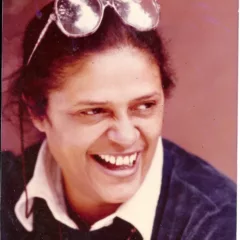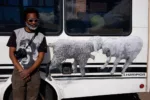
Lorraine O’Grady “Writing in Space 1973- 2019” (Duke University Press, Durham: 2020) ISBN 978-1-4780-1113-2
Lorraine O’Grady is best known for two performance works done almost forty years ago. “Mlle Bourgeoise Noir Goes to the New Museum” (1981) was an uninvited presentation, seen by a small number of people. Its only published record was the artists’s own description of a prior version of the performance (at Just Above Midtown Gallery, NYC) in the “Artists’ Chronicle” section of “High Performance” magazine and another self-penned description in the Artist’s page of the feminist publication “Heresies.” O’Grady has exhibited her costume along with a series of photographs of the event since 2007. “Art Is” (1983) involved the artist’s participation in the African-American Day Parade in Harlem; it was witnessed by the parade crowds but had no presence in the art world until 2007 when documentary photographs were shown. This volume is more than a collection of writing by an important artist whose work and thoughts have very belatedly come to larger attention. It is an extremely eloquent analysis of the New York art world since 1973 by one of the most articulate and profound conceptual artists to address questions of race, class, diasporic identity, non-Western philosophy and aesthetics and female subjectivity.
O’Grady was born and raised in Boston to Jamaican parents and came late to art after successful careers as a government intelligence analyst and a translator; she was astonished at the degree of racial segregation she found in art institutions. These essays follow her evolving experiences and analyses of the situation and document the ways in which these ideas were manifest in her work. The fluency of O’Grady’s prose is less surprising in light of the MFA in writing she had received from the Iowa Writer’s Workshop before she turned to art. She had also worked as a professional critic, initially of rock music then of art, contributing to “Artforum” from 1992-94, and taught at the School of Visual Arts 1974-2000 and U. C. Irvine 2000-05.
The volume, edited and with an introduction by Aruna D’Souza, includes artist’s statements, performance transcripts, interviews, lectures, contributions to academic and art publications (including the highly-influential “Olympia’s Maid; Reclaiming Black Subjectivity,” delivered as a paper at the 1992 College Art Association Annual Meeting and published later on multiple occasions), records of her curatorial projects, and some correspondence. She is very clear-thinking about the possibilities of socially-critical art:
“The most I really expect my work can accomplish politically is a small contribution to the task of creating a climate of questioning and refusal.”
While a retrospective of her work, “Lorraine O’Grady: Both/And” is scheduled to open at the Brooklyn Museum in March accompanied by catalog, the current publication is likely to be a much more thorough, behind-the -scenes record of her changing attitude towards art institutions and her evolution as an artist and thinker. It should be of particular interest to artists.
“Gladys Nilsson Honk!; Fifty Years of Painting” (Matthew Marks Gallery and Garth Greenan Gallery, New York: 2020) ISBN 978-1-94429-27-5
If you’ve never heard of Gladys Nilsson you’re in good company. Part of her neglect is certainly attributable to the fact that she lives and works in that blank area on Saul Steinberg’s famous map of the U.S. seen from New York City – where nothing exists between the Hudson River and the West Coast. She’s also a woman from earlier generations whose work was almost entirely ignored by male officialdom; this group includes Ruth Asawa, Senga Nengudi, Carolee Schneeman, Hannah Wilke and too many others. In addition to everything else you can say about her, Gladys Nilsson is a wonderful, technically-virtuosic painter in both watercolor and acrylic. Then there’s the fact that much of her work is funny and she doesn’t take herself too seriously; she stretched and framed several of her small paintings in embroidery hoops. This is the first substantial monograph on the artist, yet it’s published by her dealers; and besides an interview with the artist the only critical writing it contains was written by Marcia Tucker in 1973. This situation needs to change. But this monograph, handsomely produced and full of luscious, full-page images should be a good start and provides lots of visual seduction.

Nilsson paints exuberant and detailed views of a world of her own creation. She took full advantage of the huge, international range of art in the Art Institute for study and inspiration, as well as the work of self-taught artists who were notably collected by the artist community in Chicago. Her work ignores consistency of scale in highly-populated landscapes, and the line between the human and natural world is usually porous. Her beings look at and often touch each other; the sensuality is polymorphic. Nilsson was one of the Hairy Who, a group of Chicago artists, including Jim Nutt, Suellen Rocca, and Karl Wirsum, who exhibited together in the 1960s. Her work bears some relation to an earlier group of Chicago artists who forged a local response to Surrealism: June Leaf, Theodore Halkin and Evelyn Statsinger, but also to contemporaries who drew from popular culture such as Peter Saul. Nilsson’s work looks particularly pertinent in light of painters such as Sue Williams and Christina Quarles, who might be her descendants. This book offers a very welcome chance to expand her audience.









